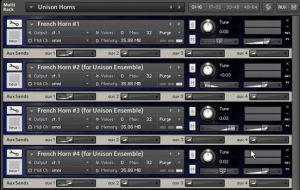Samplemodeling releases "French Horn & Tuba" for Kontakt Player and Kontakt
13th March 2012
Giorgio Tommasini & Peter Siedlaczek have announced the release of "French Horn & Tuba", the result of more than one year of R&D.
The French Horn and the Tuba were developed for Kontakt 4.2 and is available as a package for €149 (+VAT if applicable). All Samplemodeling customers are entitled to a 10% discount.
French Horn & Tuba marks the completion of Samplemodeling's Brass series. Based on anechoic multi-microphone recording, and exploiting the "harmonic alignment" technology, allowing real-time seamless transition across virtually infinite dynamics, these new instruments exploit several new features:
- Reconstruction of the original rich sound of a large instrument from its spatial emission pattern, using multi-microphone techniques, and specially devised "early reflections" impulse responses.
- Ability to construct realistic ensembles from several instruments with different timbre and response, even if driven from a single MIDI track for unison playing, by exploiting Samplemodeling's exclusive "Ensemble Maker" algorithm.
- Flexible and intuitive microtuning, allowing use of non western scales, with real time selection of the affected notes.
- Further optimisation for virtually any type of wind-controller.
French Horn and Tuba completes the Samplemodeling Brass series. Horn gestation was a long one. The real French Horn is a difficult instrument. The player must do many simultaneous things like holding appropriate lip tension, raising the soft palette, positioning the tongue, lowering the larynx, blowing air into the instrument, and pressing the valves while holding the other hand in the bell. Samplemodeling wanted their virtual French Horn to be much easier to play. Reaching this aim, at the same time retaining expressiveness and realism, proved to be a most difficult task.
Horn repertoire spaces from classical orchestral, to chamber, jazz, pop and contemporary music, both as a solo instrument and in choir. In the latter case the extended range of the horn provides the composer or arranger with more possibilities, sonically, registrally, contrapuntally. Due to the "heroic" quality of its sound, the French Horn is often used in film music, solo or in ensemble, even playing in unison. Four horns are often used for this purpose.
The Tuba is the largest brass instrument. It is used in symphony orchestras, usually as one instrument. It is the principal bass instrument in symphonic and military bands, and it serves as the bass of a brass section, and as reinforcement for the bass voices of the strings and woodwinds, and is also used even as a solo instrument.
French Horn and Tuba further expand Samplemodeling technologies. In addition to the renowned "Harmonic Alignment", yielding continuous transition across virtually infinite dynamics, multi-microphone anechoic recording, coupled to specially devised "early reflections" impulse responses, allow to reproduce the full, rich timbre of the instruments, including its radiation pattern, adding at the same time a virtual space to the anechoic sound. The programming moves further away from conventional libraries, by exploiting physically-oriented modulation of the recorded sound. This yields the characteristic crescendo pattern of French Horns, typical brass flutter on transitions, or even the "watery" sound, knocks, breath noise, and metallic resonances from the bell and the body of the instrument, greatly contributing to realism.
The package includes four different French Horns and a Tuba. The base material of the instruments consists of 260 MB of samples, chromatically performed by professional players over a very wide dynamic range. All samples are unlooped, and have a minimum duration of 9 sec. As in the "The Trumpet" and "The Trombone" the musical engine is structured according to an adaptive model, based on the performance "fingerprints" of the real instrument. The purpose of the model is to minimize the differences between the real phrases and those played by the virtual instrument.
Pseudo-random detuning and natural pitch and dynamics modulation, based on real performance-derived trends, are outstanding features of these new instruments, adding further realism.
Advanced "Artificial Intelligence" MIDI processing techniques are used for real time construction of all articulations and morphing across dynamics, vibrato, legato, portamento, trills, flutter tongue, vibrato-like endings, shakes and so forth.
Special consideration has been given to creation of realistic ensembles from solo instruments, whether driven form separate MIDI tracks or when playing unison. An advanced "ensemble maker" has been developed, affecting timing, static and dynamic pitch evolution, phase, response to dynamics, pitchbend, velocity, portamento times, in such a way that each instrument of the ensemble sounds as if driven from a different track even if played in unison. Unlike conventional ensemble libraries, any articulation will always sound different, yet real. A ready-to-use Multi, including four specially devised French Horns, suitable for unison playing, along with an appropriate convolution reverb is included in the package.
An entirely new feature of French Horn and Tuba is microtuning, to better cope with other, non-tempered scales – so essential in, for example, Middle Eastern and Asian music. Samplemodeling's approach to microtuning yields maximal flexibility, allowing user-defined scales, where the extent of detuning (range +60/-60 cents) can be precisely set for each note by means of a sliding bar. The scale can be saved and recalled as a preset.
In addition, selective detuning can be applied to individual notes in realtime. by using third-level keyswitches, similar to those used for split portamenti, falls and doits. In this case, all notes are detuned by a predetermined amount (up to +/-60 cents), which may set and modified by the user.
KVR Audio, Inc.
www.kvraudio.com


